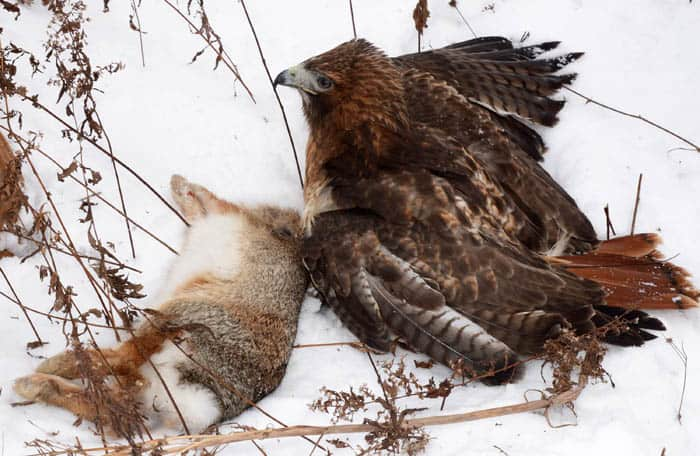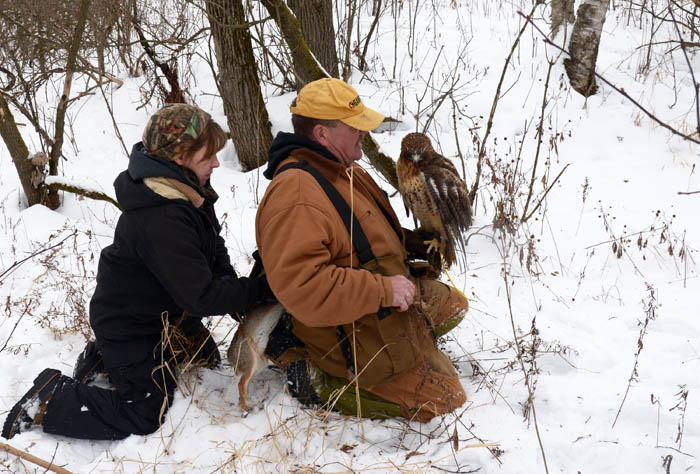Rabbits Are No Pushovers, Even for a Trained Hawk
Patrick Durkin 03.22.16

Falconry is tritely called “the sport of kings,” but it’s doubtful many kings ever tromped through thick brush and foot-deep snow to flush rabbits for their ever-vigilant red-tailed hawks.
No, those royals had serfs like me doing such work—and loving it. In fact, except for trading my shotgun for a camera and walking stick, my hawking hunt in January with Patrick and Kelly LaBarbera of Black River Falls resembled hundreds of other rabbit hunts I’ve made since childhood.
For this hunt, however, we left all hunting to Nala, the LaBarberas’ 5-year-old red-tailed hawk. As we humans poked through railroad ditches, weaved across creek bottoms, and beat the brush along never-ending fencerows, Nala watched for fleeing prey from perches high in oaks, pines or locust trees, regularly relocating for better views.

We had barely left our trucks for the first hunt when Pat bellowed “ho-ho-ho-ho-ho!” as a cottontail burst from thick weeds 10 yards away and zigzagged through the woods. His yell was meant to alert Nala, but she was already airborne – ankle bells jingling – as she tracked the rabbit’s run. After a quick assessment, she tucked her wings and dove through tight openings in the brush to intersect the rabbit.
But just as this feathered missile snapped out her wing-brakes and rammed her talon-tipped toes into a death-strike, the cottontail cut right, darted behind a bush, and raced to safety down the creek-bottom.
“If you just want to fill your game pouch, carry a shotgun,” Pat said with a laugh. “You have to walk a little farther and hunt a little harder to get your limit of rabbits with a hawk.”

Yes, birds of prey don’t bat 1,000. In fact, if our five-hour hunt that day was any indication, their batting average is about .400. That mark makes more sense when you consider cottontail rabbits live every day under the threat of airborne assault from red-tailed hawks and other avian predators. Life is brief for small prey that don’t keep brush between themselves and winged predators.
A few minutes and maybe 150 yards later, Kelly LaBarbera flushed another cottontail, which bolted from snow-covered brush and dashed across a field with scattered trees. Pat and I heard Nala’s bells jingling as she cast off from a nearby oak, but couldn’t see her lightning-quick strike on the unsuspecting rabbit.
When Kelly confirmed our first kill, Pat walked over to claim the prize. Unlike hunters with dogs, however, falconers don’t expect their bird to exchange the kill for mere praise and a head scratch.

The “transferring off” from hawk to falconer requires a practiced mix of trickery and trading to ensure the bird’s trust. Snow makes the swap a bit easier. With Nala still latched onto her kill, Pat held a piece of raw meat near her menacing beak while Kelly scooped snow over the dead rabbit.
“Out of sight, out of mind,” Pat explained. “Falconry is a partnership with your bird. You have to treat them fairly.”
Once Nala hopped aboard Pat’s heavy-leather falconry glove to eat, he turned his back to the snow-covered rabbit to put his coat’s game pouch within Kelly’s reach. With Nala distracted, Kelly pulled the rabbit from the snow and slipped it into the pouch.
“That rabbit had little chance once it took off across the field,” Pat said.
Kelly agreed. “It wasn’t worried about a hawk. It was just trying to get away from me. That’s why it ran into the field.”
Not all rabbits are so unlucky. The LaBarberas said it’s easy to see when rabbits detect a hawk. “They run out there, but then stop and hunker down low,” Kelly said. “Or they’ll run right at you because you aren’t as much of a threat as a hawk.”
About a half-hour later, we saw another rabbit beat the odds. As Pat pushed through a well-tracked brush patch above a dry creek bed, a rabbit dashed into a field and raced for the nearest woods.
Nala soared from her perch about 100 yards away, circled shortly to gain altitude, and then rocketed toward the rabbit. But just as the hawk braked, and milliseconds before it slammed into the snow, the rabbit also braked and cut hard to its left, leaving the hawk empty-taloned. Nala simply watched as the rabbit reached the woods.
“A redtail can’t strike again once it’s on the ground,” Pat said. “It needs to start over and ‘ladder up’ high so it can build speed for another strike. When hawks strike, they hit so hard you’d think they’d break every bone in their own body. That’s why they often kill rabbits on impact.”
While returning to our trucks and driving into town for coffee and a late breakfast, Pat explained that falconry isn’t just about hunting with peregrines, kestrels or other falcons. The term also includes goshawks, Cooper’s hawks and red-tailed hawks. Nala is his third red-tailed hawk, which he considers the “F-150” of falconry.
“Redtails are hardy, healthy, reliable and good-tempered,” Kelly said. “They’re easier to work with.”
After eating, Pat suggested we try one more woodlot before heading home. Once we parked, he removed Nala from her travel-box and released her to find a perch. We then separated to push a brushy ditch whose snowy cover was stitched with rabbit tracks and littered with their pellets.
I turned when hearing Kelly shout “ho-ho-ho-ho-ho!,” and saw Nala miss another strike. The hawk soon flew to a new perch and then, for reasons known only to her, flew deep into the woods and out of view. When whistles, shouts and a lure of fresh meat swung on a cord didn’t coax her back, Pat went searching for her.
Minutes later we saw him returning, with Nala shadowing him along the woodlot’s edge. Suddenly a rabbit shot from weed-choked brush yards away, causing us all to yell “ho-ho-ho-ho-ho!” in near unison. Again, though, Nala didn’t seem to need the help. She was already airborne and diving.

We’ll never know how she sliced through all those tree branches and brush to strike the rabbit, but she didn’t miss. After the LaBarberas transferred the rabbit to Pat’s game pouch, he smiled and explained another benefit of “hawking rabbits.”
“You don’t worry about biting into shotgun pellets when you eat these rabbits,” he said. “The only damage to the meat is the talon holes and a little bruising from the impact.”
And they don’t forget Nala when dividing the hunt’s rewards.
“We get the meat, and she gets the head and all the organs,” Pat said. “We all eat well.”
But of course. Isn’t that how all kings and other royalty eat?


